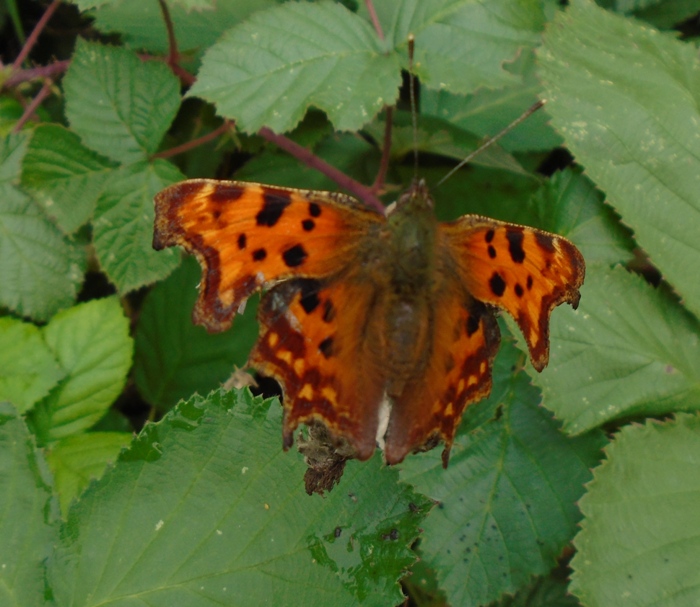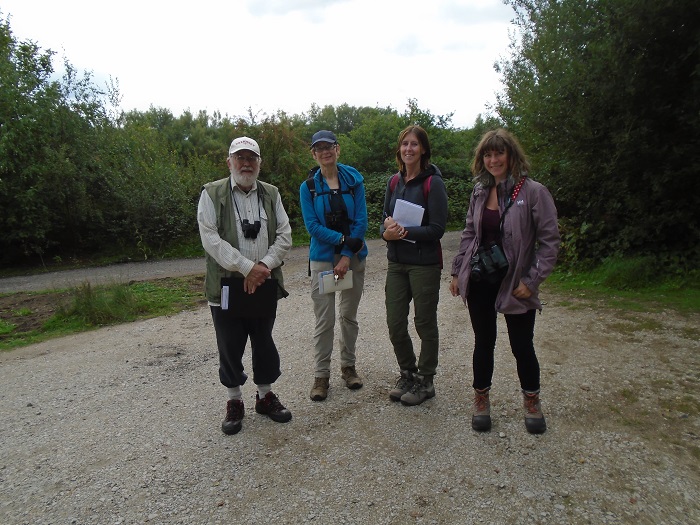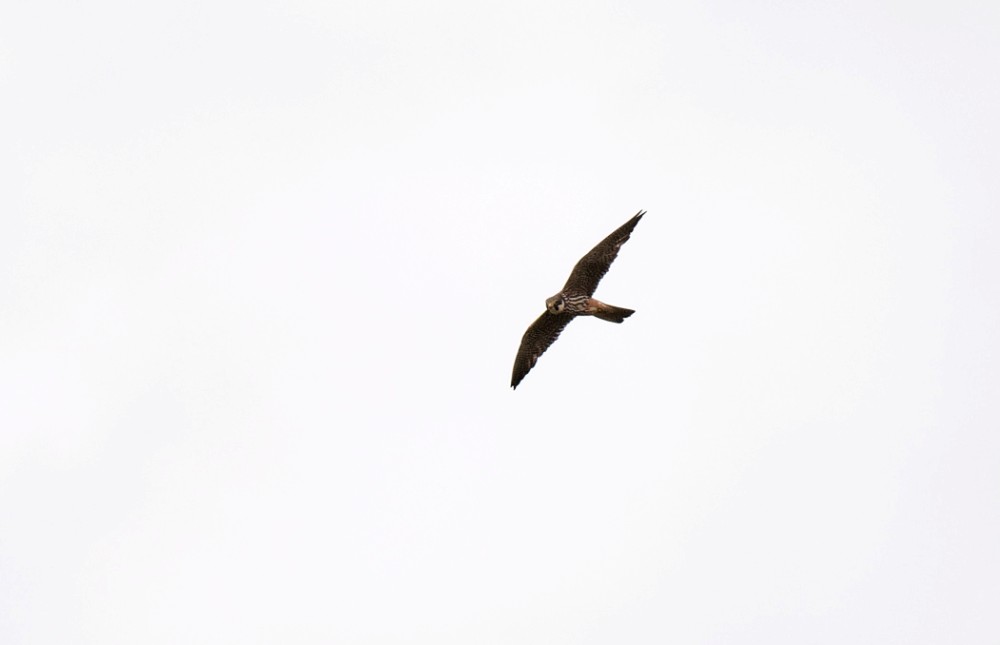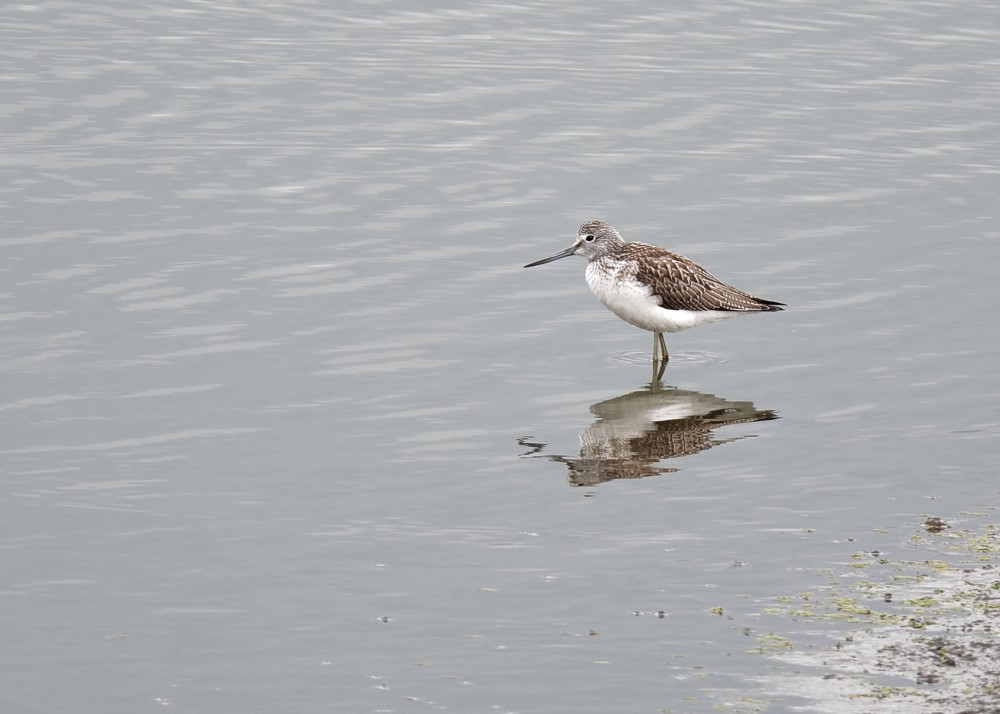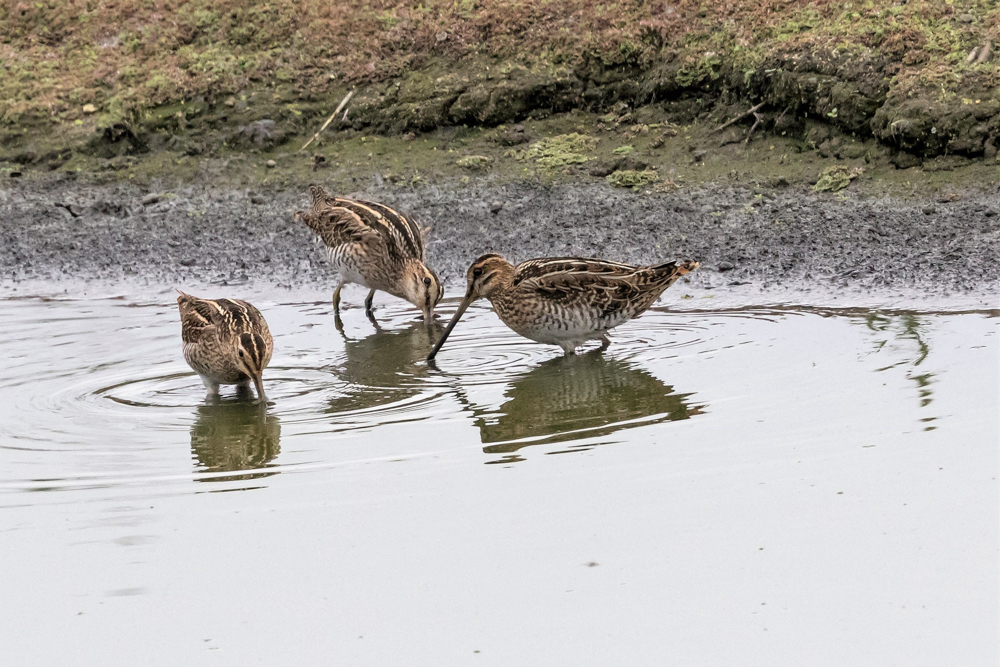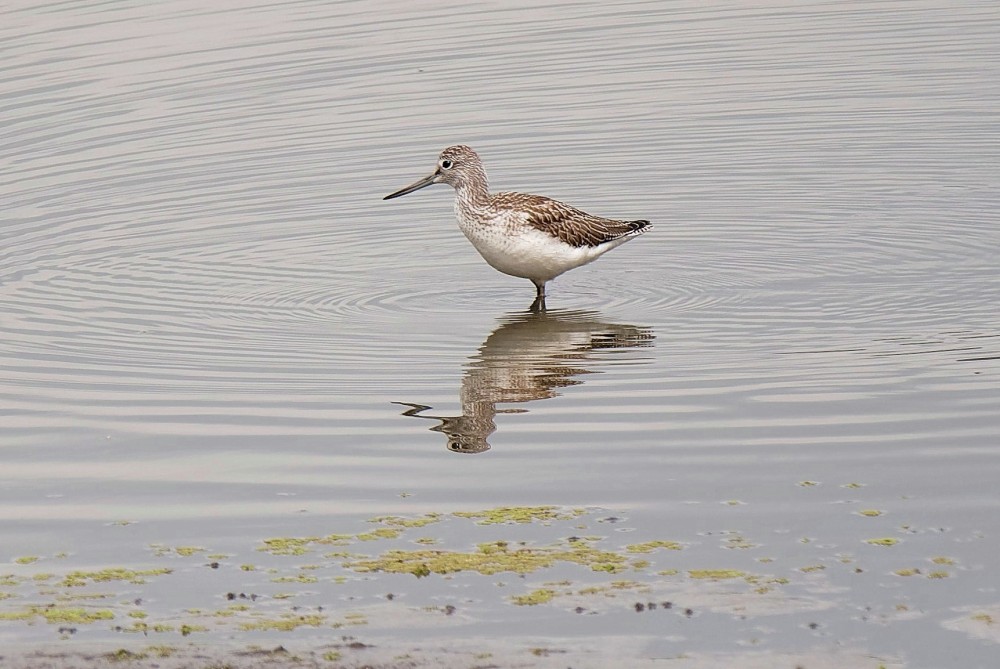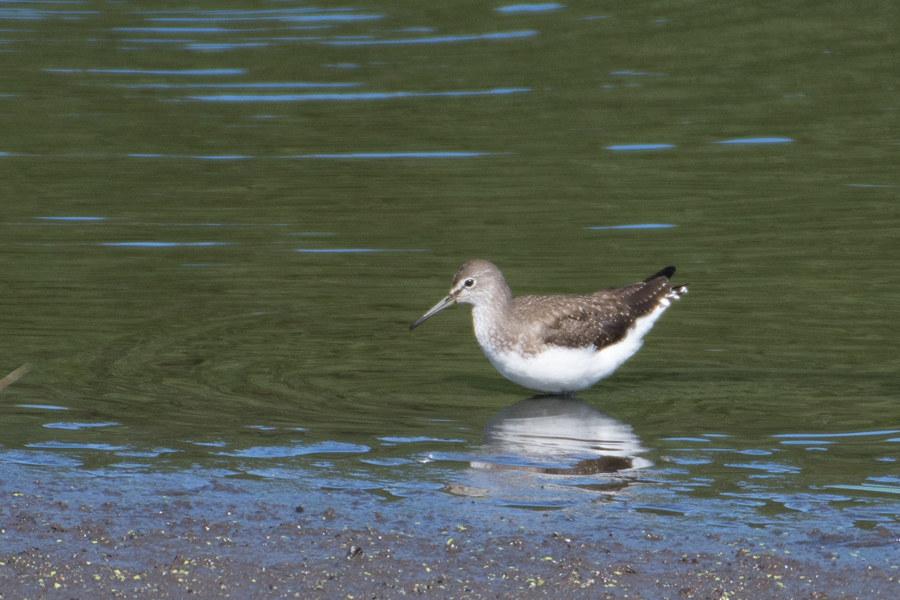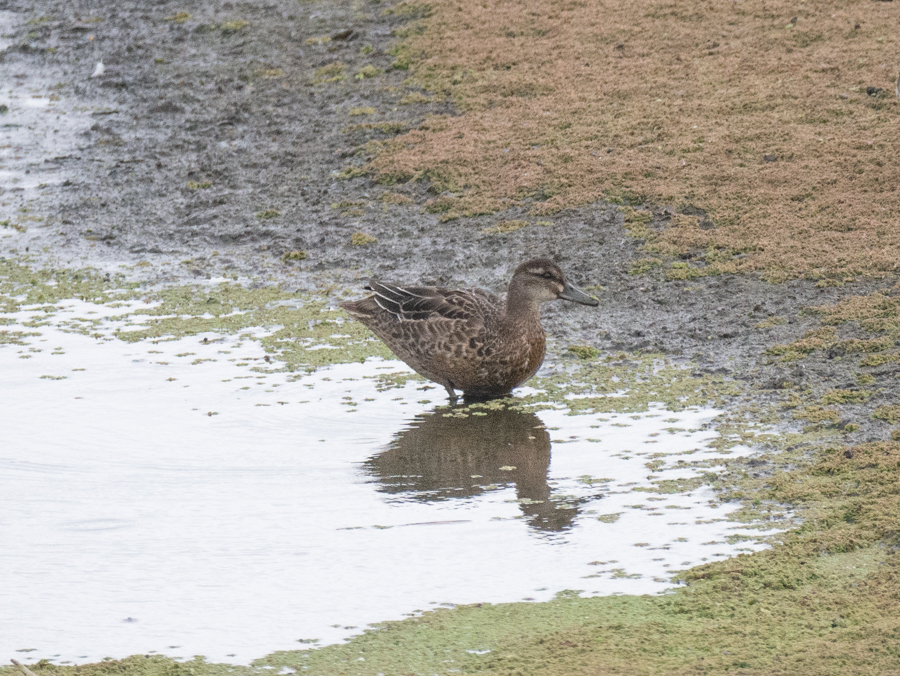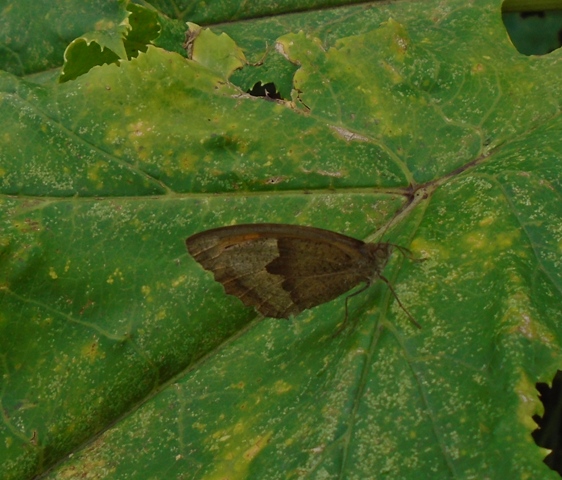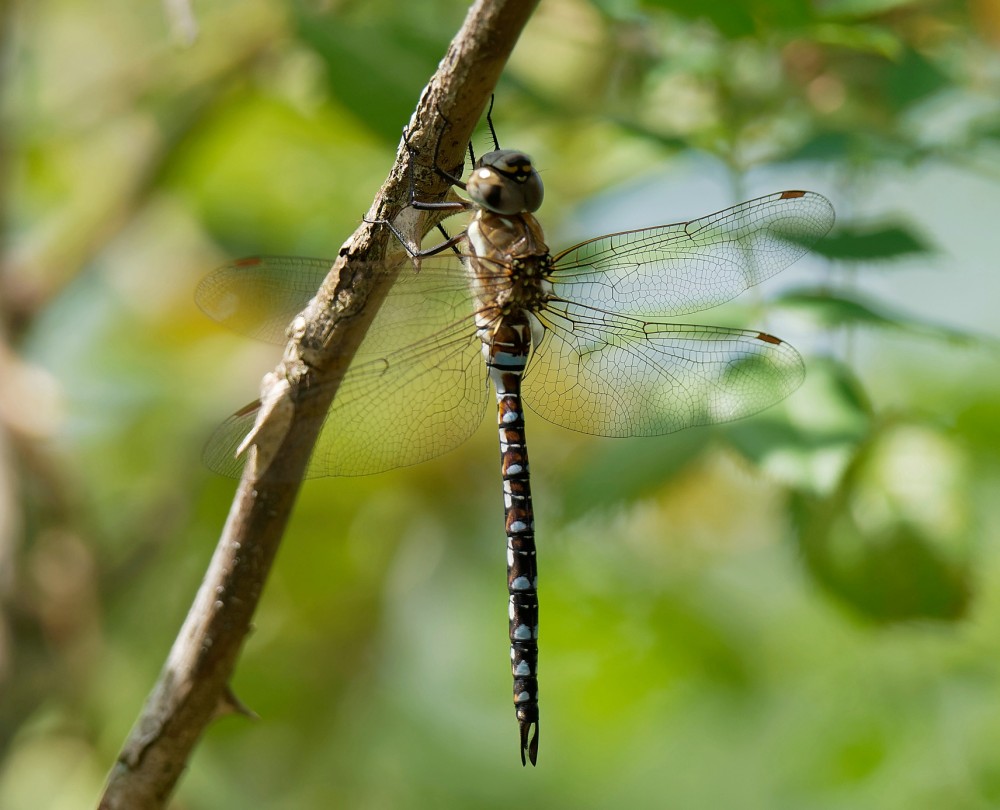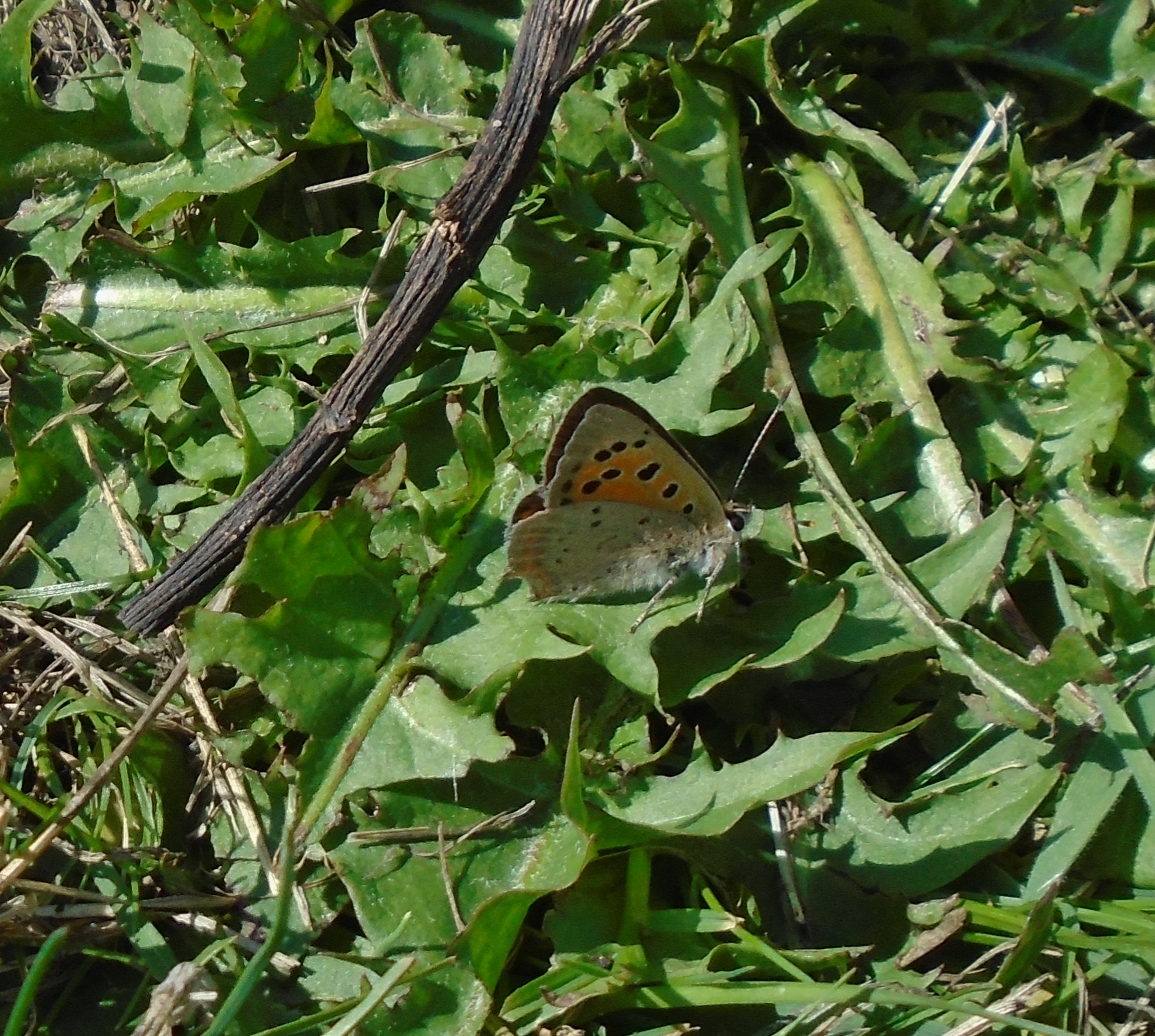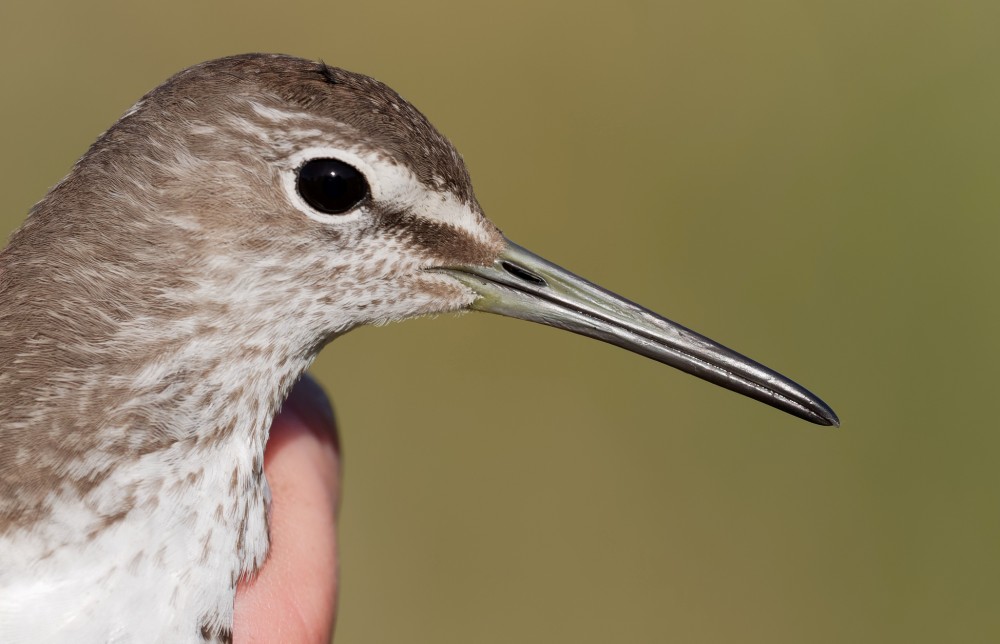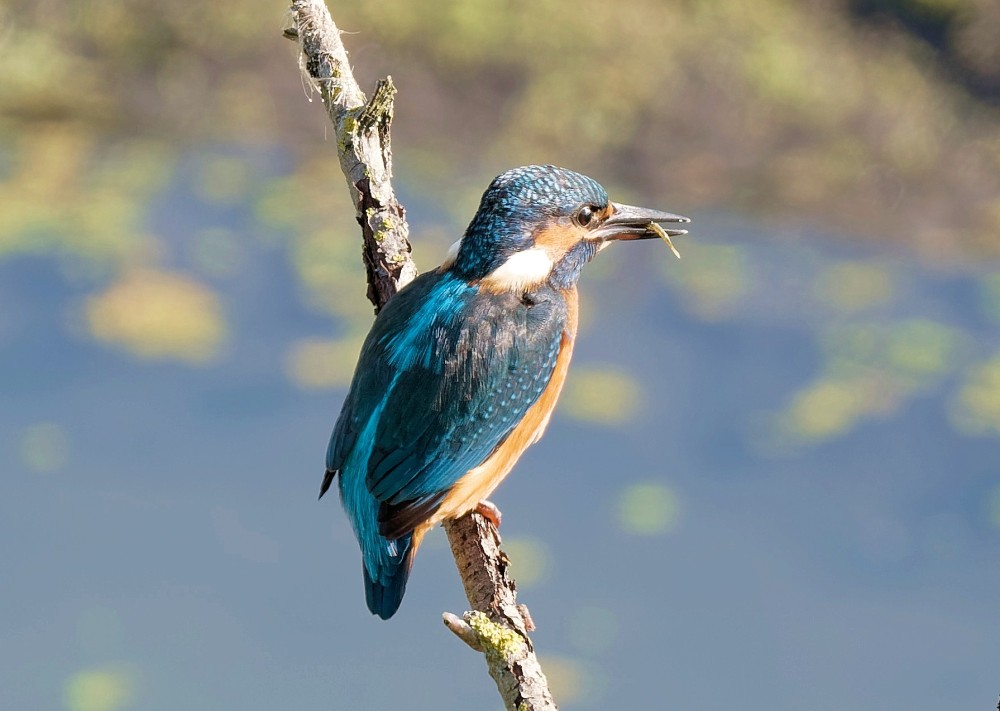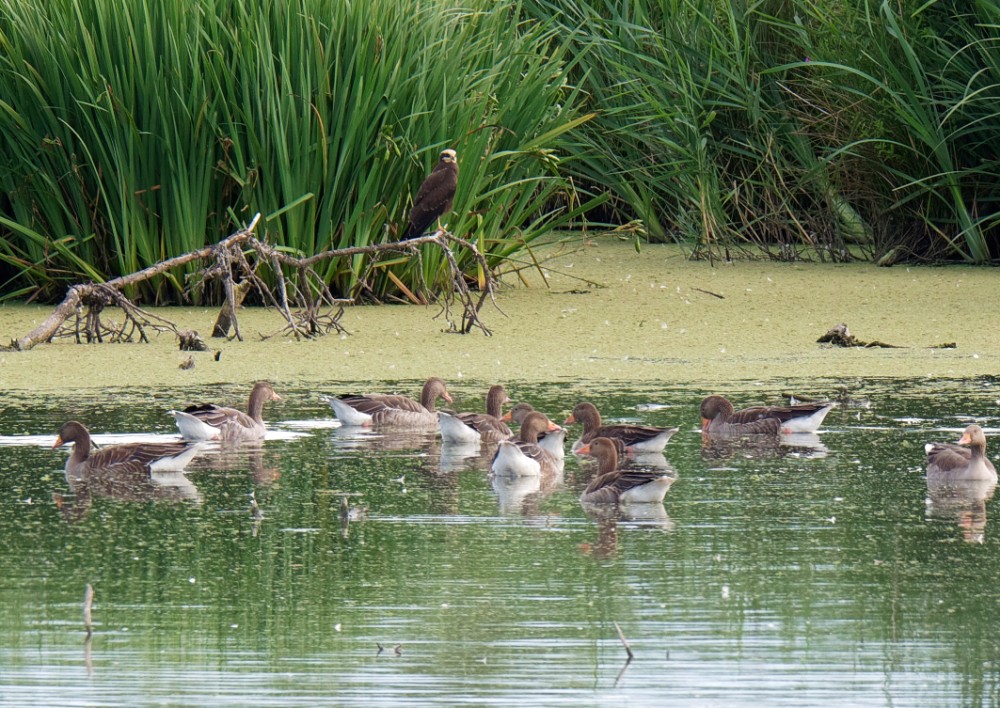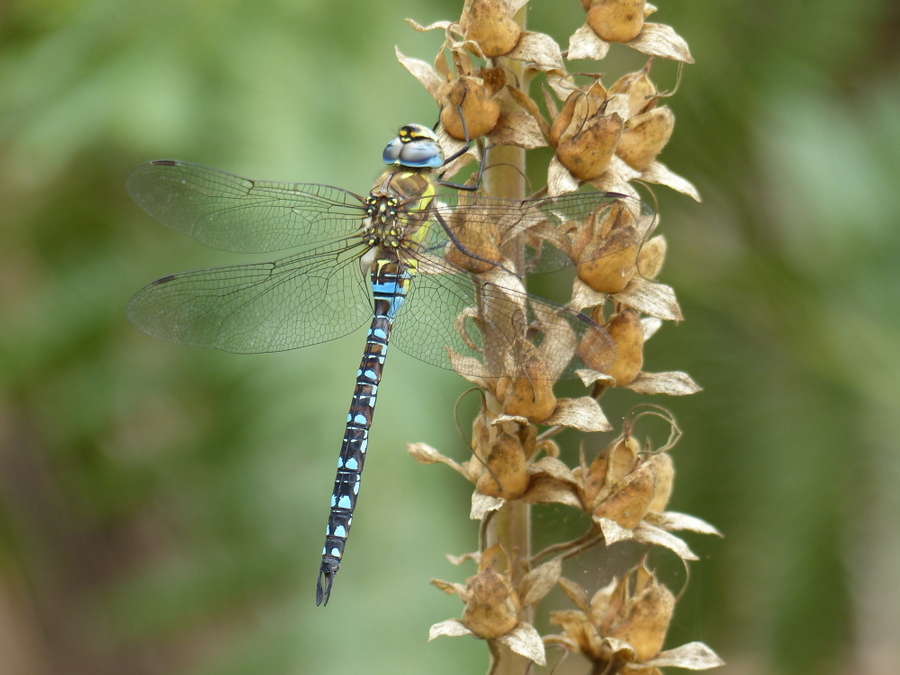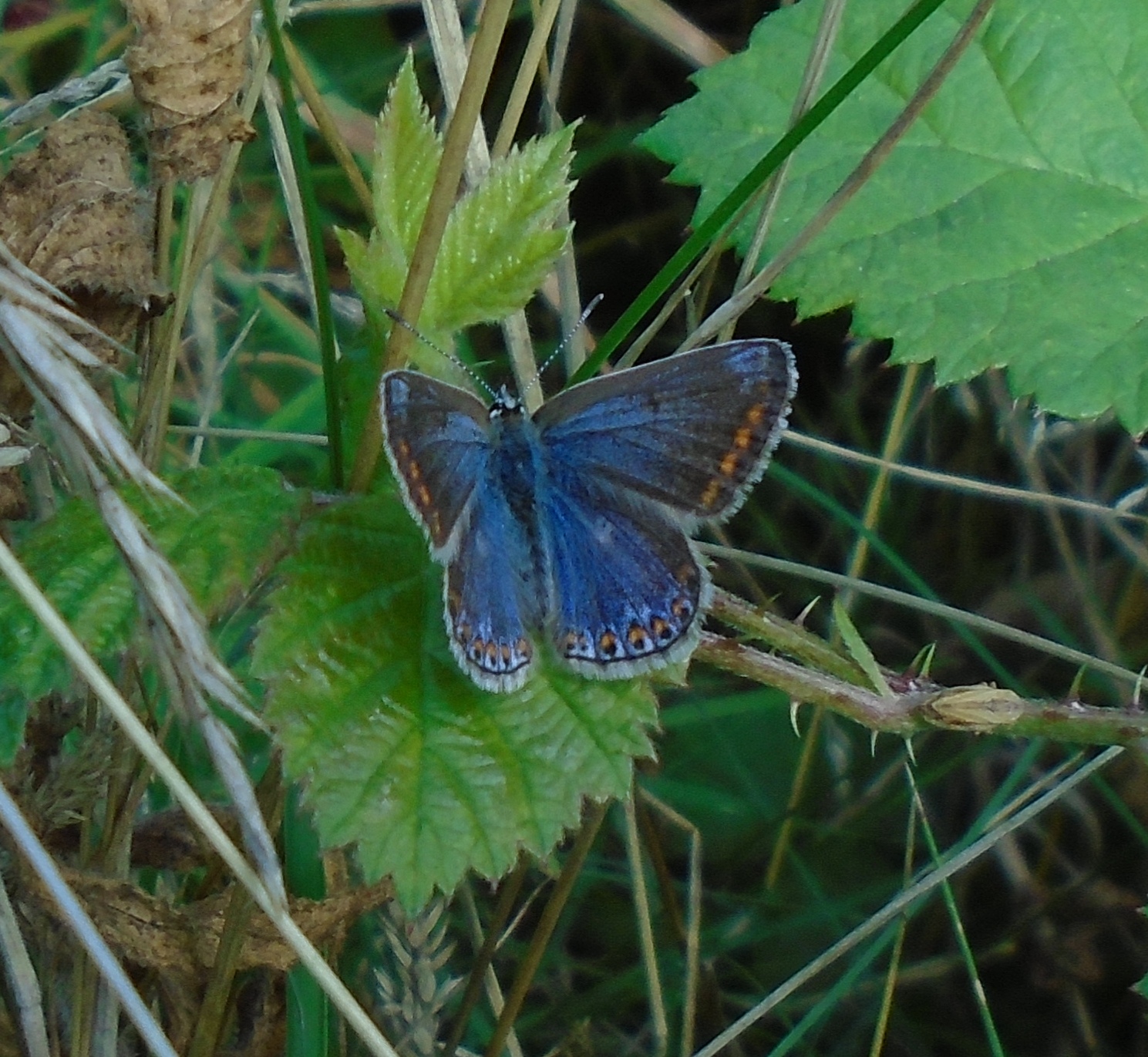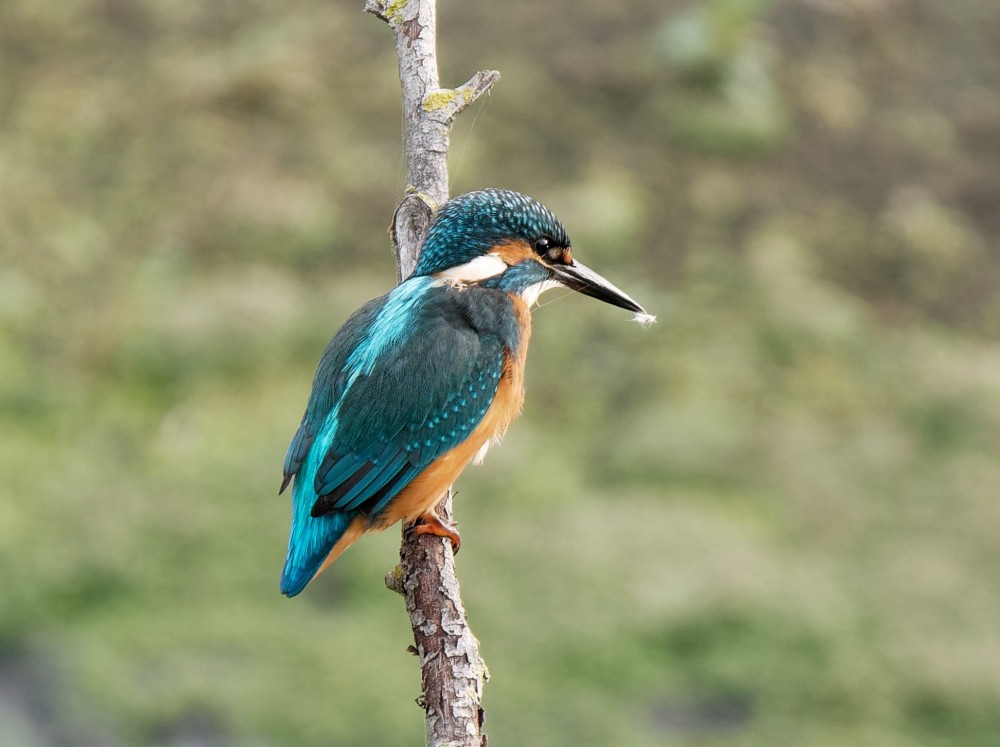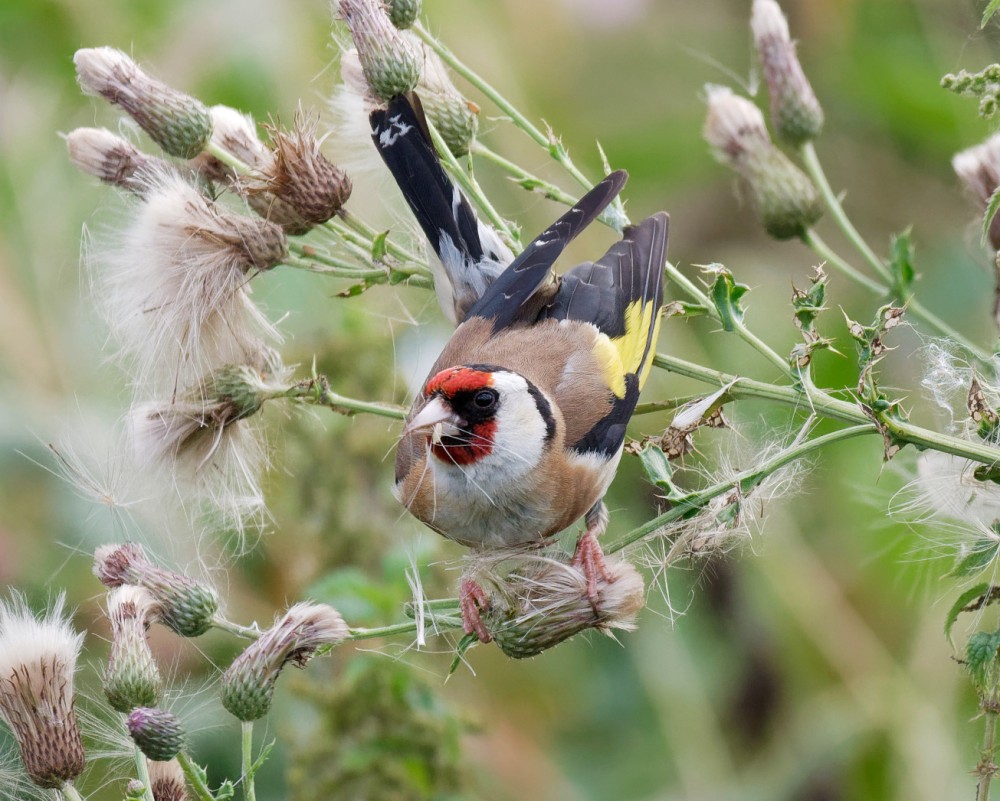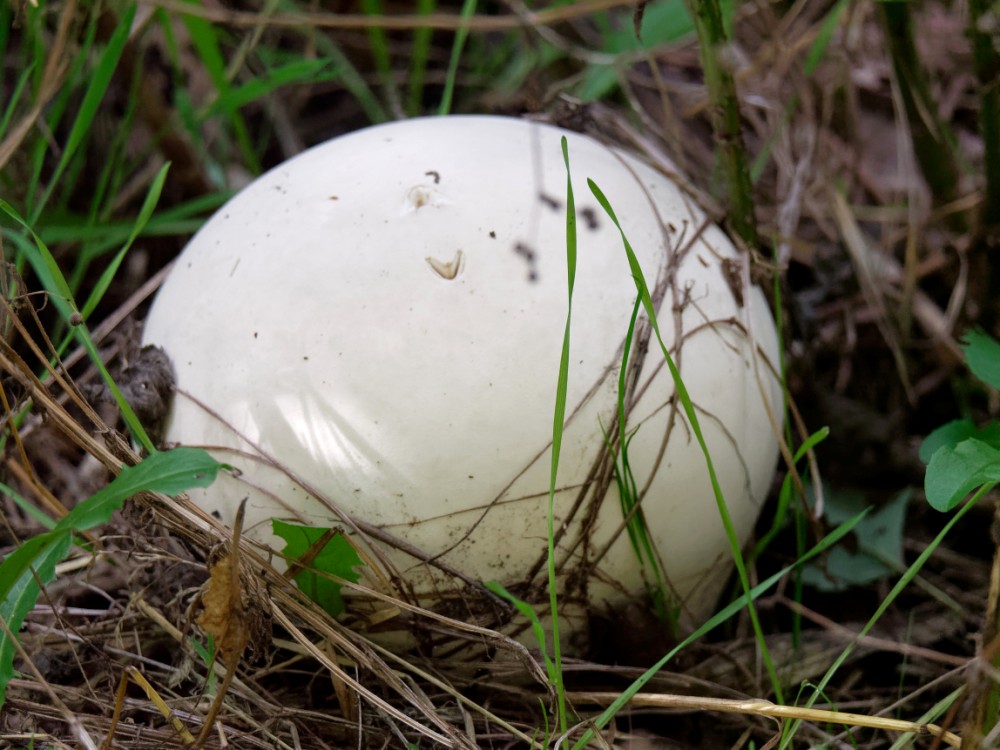Woolston Eyes Monthly Sightings
2018-08-30
There was an autumnal feeling in the air this morning as I set out on my tour of the reserve. Perhaps the most notable sightings of the day were the large numbers of geese present. A total of 160 Canada Geese included 140 at Bollin Point and 62 Greylags were on No.3 bed. Other totals of interest were 110 Mallard, 61 Tufted Duck, 161 Gadwall, 75 Teal and about 50 Shoveler, the latter on No.3 bed. Waders included 167 Lapwing, 23 Black-tailed Godwits, 2 Snipe and a Green Sandpiper. A Water Rail was calling in front of the Rotary Hide. 8 Little Grebes included one with 2 young on the river to the north of No.2 bed. A flock of 150 Goldfinch was in the centre of No.4 bed. Butterflies were disappointing even though the sun came out after lunch. Speckled Woods totalled 21 with 4 Commas, 18 Whites (mostly small) and a single Common Blue. Photo; Comma on No.2 bed.
Submitted by: Dave Hackett
2018-08-28
This morning we hosted a butterfly identification workshop in conjunction with the Carbon Landscape project. With the help of Derek Britch those attending were given information on how to identify common butterflies and the opportunity to walk the butterfly transect. In spite of the often cloudy weather we found a total of 23 butterflies on the transect, including a Small Tortoiseshell and a late Meadow Brown. David Bowman was on hand in the John Morgan Hide to point out a variety of waders through his scope, including Green Sandpiper, Black-tailed Godwit and Greenshank. Photo; group of attendees with Derek
Submitted by: Dave Hackett
2018-08-28
Conditions were good for observing return passage at Woolston Eyes today, with the day warming nicely as afternoon approached. Early on, David Spencer had watched 10 Redshanks drop in to join the single Greenshank, five Green Sandpipers, 17 Black-tailed Godwits, 8 Snipe and 200 Lapwings already present on the bed. The Redshanks had moved on by the time I arrived at 10.30 am, but there was still plenty to see. As ever, Kingfisher and Water Rail were recorded, while 30 Swallows and eight House Martins moved south. It was also pleasing to pick up a solitary Swift, feeding high over the east bank - won’t be long before they’ve all gone south. Raptors were very active, with ten Common Buzzards, three Sparrowhawks and a Kestrel over the bed before the star turns arrived - two Hobbies which spent a lengthy period hawking over the bed, regularly catching dragonflies which were rising on the warm air. The photo is of the morning’s Hobbies. Cheers David Bowman
Submitted by: David Bowman
2018-08-25
The combination of spectacular skies and a good variety of birds made for a thoroughly enjoyable morning on No.3 bed. The scudding clouds and frequent heavy showers provided the backdrop for a steady trickle of migrants. First through were two Little Egrets, heading north-west, followed by singles of Ringed Plover and Golden Plover, the latter two being very scarce visitors to the Reserve. Hirundines were regularly being brought down to feed by the showers and totals were: 140 Swallows, 25 House Martins and 5 Sand Martins. Pleasingly, towards the end of the morning, three Swifts also dropped in. The wader flock on the bed had reduced slightly from earlier in the week, with two Greenshanks, 2 Green Sandpipers, 18 Common Snipe, 17 Black-tailed Godwits and 110 Lapwings. The 100 or so Greenfinches on the Morgan Hide feeders drew in several Sparrowhawks, while half a dozen Buzzards and a Peregrine made up the complement of raptors. The photo is of one of today’s Greenshanks.. Cheers David Bowman (with David Spencer, Helen Wynn, Dave Steel, Alan Warford, Sue Haddock and Les Jones)
Submitted by: David Bowman
2018-08-22
In spite of generally cloudy conditions there were some good butterfly totals, including yesterday’s transect count. 66 Speckled Wood and 36 Common Blues were noteworthy whilst 2 Small Coppers and a Painted Lady added interest. Birds seen included 3 Greenshanks on No.3 bed together with the usual Lapwings and Godwits. A young Peregrine was on the viaduct and a reserve total of 9 Grey Herons was my highest for some time. A single Grey Partridge, presumably the same bird seen a couple of weeks ago in the same location, was on Butchersfield Tip.
Submitted by: Dave Hackett
2018-08-21
Well, that was a nice flurry of autumn passage this morning/afternoon. Early on, David Spencer had reported a passing Curlew, plus a Dunlin, three Greenshanks and three Green Sandpipers on No.3 bed. When I arrived, three Greenshanks were in front of the Rotary Hide, two of which soon flew west. From the Morgan Hide, six Greenshanks, five Green Sandpipers, a Dunliin, 55 Black-tailed Godwits, 12 Common Snipe and 80 Lapwing, feeding actively, made for some rewarding wader-watching. The local Kingfishers and Water Rails also put in appearances, while overhead three Swifts and six Swallows were hawking and 12 Pied Wagtails were picking insects off the mats of water-weed. The afternoon’s peace was then somewhat disturbed by the raucous arrival of 60 Greylag Geese and the attentions of a marauding juvenile Peregrine. Cheers David Bowman
Submitted by: David Bowman
2018-08-18
A 6.30 am start, under gloomy skies started with a female/juvenile Garganey in front of the Morgan Hide and 40 Black-tailed Godwits spread out over the lagoon. A single Green Sandpiper then appeared, feeding alongside eight Common Snipe. The Marsh Harrier, which is now entering the fourth week of its stay with us, started hunting mid-morning and was constantly unsettling the feeding waders and wildfowl, which included several hundred Gadwall, 50 Shovelers and scores of Teal. The harrier then demonstrated its aerial abilities, during a prolonged duel with one of the local Sparrowhawks. The only passage of note, early on, was of a few hirundines of all three species until a group of 60 Swallows flew determinedly south. Later on 12 Swifts moved westward, two Yellow Wagtaild arrived to feed with a small flock of Pied Wagtails and, as ever, a Kingfisher was active in front of the Morgan Hide. Kieran Foster and the ringing team were also having a good morning, with Grasshopper Warbler, Cetti’s Warbler and Garden Warbler among the ten warbler species ringed. Photo of the Grasshopper Warbler from today. Cheers David Bowman (with David Spencer, Diane Shepherd, Sue Haddock and Brian Baird)
Submitted by: David Bowman
2018-08-17
Photo of one of the Garganey which has been frequenting the scrape this week. It was still there today along with the Marsh Harrier and at least 2 Green Sandpipers. Also today Dave Riley caught a Tree Pipit on No.1 bed.
Submitted by: David Spencer
2018-08-15
A flying, lunchtime visit to Nos.3 and 4 beds today, still managed to deliver some good birds. Our collective records from today included: two Garganey, one Tree Pipit, two Greenshanks, 2 Green Sandpipers, 11 Common Snipe, two Common Terns, 75 Black-tailed Godwits, one Peregrine, two Garden Warblers, four Water Rails and a Kingfisher.
Cheers David Bowman (with Bert Lloyd, Mike MIles, and John Barber)
Submitted by: David Bowman
2018-08-14
A cloudy but warm day for my weekly walk around the reserve It was fairly quiet but a number of interesting sightings brightened the day. Over 600 Black-headed Gulls were on the canal and river and 34 Mute Swans and two broods was a good count, as was a total of 7 Grey Herons. Including Monday’s count on No.3 bed, Gadwall totalled 369, a little down on the previous week. On No.3 bed on Monday evening were about a hundred House Martins and 50 Sand Martins together with a Little Egret. Today found a juvenile Peregrine on the viaduct and 2 Ravens flying north over No.1 bed. Given the cloudy conditions few butterflies were on the wing but there is reason to suppose that Common Blues, currently totalling 239, may not have yet reached their maximum numbers. Photo; Meadow Brown on No.4 bed
Submitted by: Dave Hackett
2018-08-13
An early evening visit to No.3 bed at Woolston Eyes, under cloudy skies for once. Not much passing through, other than 20 Swifts and a few hirundines but plenty of wader and raptor activity. The Black-tailed Godwit flock seems to have settled at 57 for the moment, while just one Green Sandpiper visited the Morgan Hide scrape and four Snipe and 180 Lapwings were out in the shallow water. The Marsh Harrier, which is now entering the third week of its stay, repeatedly flushed the waders and wildfowl and a juvenile Peregrine also made a couple of high speed passes, while several Sparrowhawks and Buzzards also put in appearances.
Cheers David Bowman
Submitted by: David Bowman
2018-08-12
Photo of an early Migrant Hawker, taken on No.3 bed on 25th July.
Cheers David
Submitted by: David Bowman
2018-08-11
Although numbers of some species of butterflies have probably peaked, a further 5 Common Blues found today along the Canal Track and on the north meadow of No.3 bed brought the reserve total for the past week to an impressive 232. A Small Copper has been reported on the north meadow path over the past few days and was still present today; see photo
Submitted by: Dave Hackett
2018-08-11
Photo of a Green Sandpiper ringed on No.3 bed today.
Cheers David
Submitted by: David Bowman
2018-08-11
With the water levels on No.3 bed dropping steadily, this is the time of year to be on the lookout for passing waders. Today it was seven Dunlin and a Greenshank which moved through, while the feeding wader flock contained two Green Sandpipers (though there are probably a minimum of five on the bed), 77 Black-tailed Godwits, four Snipe and 80 Lapwings. The increase in muddy margins for feeding also increased the visibility of the local Water Rails, with three seen well and two more calling from cover. As usual, at this time of year, one of the resident Kingfishers spent a good while fishing from its perch in front of the Morgan Hide. Birds of prey were also on the hunt, with one Peregrine, two Sparrowhawks and 13 Common Buzzards joined, at lunchtime, by the long-staying Marsh Harrier, which gave great views, both perched and in flight. Photo of a Common Buzzard from today
Cheers David Bowman (with David Spencer, Helen Wynn, Dave Steel, Brian Baird and Les Jones)
Submitted by: David Bowman
2018-08-09
It’s always exciting to walk onto No.3 bed at this time of year, hearing Black-tailed Godwits calling and wondering which other waders might also turn up. This morning started well at 6.15 am, with yesterday’s three Garganey still feeding out from the Tower Hide. The Godwit flock had increased to at least 54, with eight Snipe and 60 Lapwings also present. A couple of Green Sandpipers were in front of the Morgan Hide and then a Greenshank flew in, calling and touched down briefly before flying in the direction of the Linley Hide. One of the local Kingfishers was looking well-settled on its perch in front of the Morgan Hide till the Marsh Harrier, which has now stayed for nearly two weeks, came out of its roost and set all the waders in motion, something it did repeatedly all morning. Later, a juvenile Peregrine also caused a stir, skimming over the lagoon and causing panic. Kieran Foster’s ringing team also had a good morning, with nine new Garden Warblers and a Cetti’s Warbler caught, along with scores of commoner species. Walking off the bed, after also squeezing in a productive meeting with Anna Hetterley and Anthony Da Silva from the Carbon Landscape (to plan some wildlife training workshops) it was nice to see four Migrant Hawker dragonflies along the track. Photo of the Marsh Harrier Cheers David Bowman (with David Spencer)
Submitted by: David Bowman
2018-08-07
The first Migrant Hawker Dragonflies were present on No.3 bed today.
Submitted by: Brian Baird
2018-08-07
A survey of the northern section of No.1 bed on Sunday 5th August resulted in a total of 182 Common Blue butterflies and a reserve total of 217. Small Whites have been present in excellent numbers and over 400 have been found across the whole reserve. Monday evening on No.3 bed produced a total of 14 Purple Hairstreaks, nearly all on the south bank. Also present were 400 Gadwall and 46 Black-tailed Godwits. Today’s walk was equally productive with a Grey Partridge and a Holly Blue on Butchersfield Tip and a good variety of birds on No.3 bed including the long-staying Marsh Harrier, a Yellow Wagtail and 120 Lapwing. Photo; Common Blue Butterfliy
Submitted by: Dave Hackett
2018-08-07
Wader passage on No.3 bed picked up pace this morning. Counting the birds was helped by the continued presence of a female Marsh Harrier which, regularly flushed the feeding flocks. Early on, Kieran Foster and his team caught and ringed three Green Sandpipers, while a fourth un-ringed bird later appeared on the Morgan Hide scrape. The Black-tailed Godwit flock held 47, while a group of 14 Snipe were disturbed from cover by the harrier. A Kingfisher was fishing in front of the hide, while a single Yellow Wagtail, five Linnets and plenty of Goldfinches dropped onto the scrape. As well as Buzzards, Sparrowhawks, Kestrel and Marsh Harrier, a single Hobby and three Peregrines soaring together made up the raptor complement. The latter were almost certainly the two juveniles from he local breeding site, in company with one of the adults. The link to the video clip shows most of the activity in front of the Morgan Hide today.
Click here to watch David’s video or cut and paste the link below into your browser…
https://youtu.be/QUJPeJ16xhkt
Cheers David
Submitted by: David Bowman
2018-08-04
An early start on No.3 bed this morning produced, as ever, a good variety of sightings. A Hobby was over the bed first thing, while 28 Black-tailed Godwits, 5 Snipe and 65 Lapwings made up the wader complement. Two Ravens then slipped over, heading east and, after a long vigil, the Marsh Harrier put in a showing, completing a week long stay. A Water Rail creeping around the muddy margins, a Kingfisher on the regular perch in front of the Morgan Hide and a Willow Tit were the pick of the resident species. Aerial feeders were passing through in small numbers, with 70 Swifts but just a handful each of Swallows, Sand Martins and House Martins.
Photo of a Kingfisher from the Morgan Hide
Cheers David Bowman (with David Spencer, Helen Wynn, Sue Haddock and Brian Baird)
Submitted by: David Bowman
2018-08-02
A 5.45 am start on No.3 bed this morning, as ever produced an excellent variety of birds. Early on a Hobby was hunting the few Swallows and Sand Martins coming out of a small overnight roost. On the muddy edges of the lagoon a single Green Sandpiper, 3 Snipe and 11 Black-tailed Godwits were settled and feeding. Or , a at least they were, until the Marsh Harrier which has been present all week, came out of its roost and scattered them across the bed. Two Kingfishers then came to fish in front of the Morgan Hide, while 60 Swifts dropped in to feed on aerial prey,over the north bank. Kieran Foster and his ringing team also had a good morning, catching a second juvenile Kingfisher (after one yesterday), a juvenile Cetti’s Warbler from one of our breeding pairs and a couple of Garden Warblers, along with the commoner stuff. Photo of a Goldfinch from this morning. The link to a video clip shows the two Common Terns and Yellow Wagtail which perched on the nest rafts yesterday, as well as demonsrating the elegance of the Marsh Harrier’s flight (as a bonus, some of the latter is even in focus)
Click here to watch David’s video or cut and paste the link below into your browser…
https://youtu.be/UJ-tZfCR2uQ
Cheers David Bowman
Submitted by: David Bowman
2018-08-01
A bit of a Groundhog Day on No.3 bed this morning, with pretty much the same key species as yesterday. Records included: one Yellow Wagtail perched on a raft with two Common Terns, the Marsh Harrier still present early on, 18 Black-tailed Godwits, one Green Sandpiper and three Snipe feeding in the shallows, three Kingfishers in front of the Morgan Hide and a hunting Peregrine.
Photo of a Giant Puffball (I think!)
Cheers David Bowman (with David Spencer, Bert Lloyd and John Verdon)
Submitted by: David Bowman

